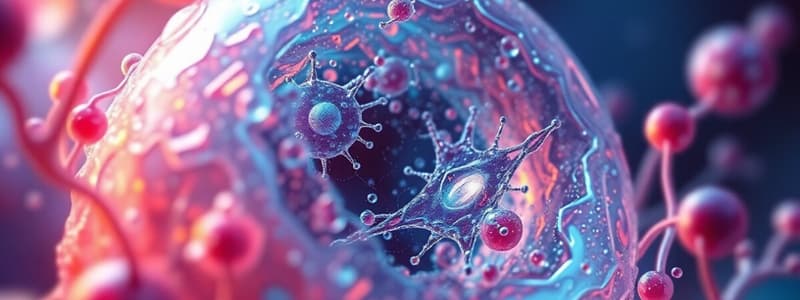Podcast
Questions and Answers
What did Francesco Redi's experiment in 1668 aim to disprove?
What did Francesco Redi's experiment in 1668 aim to disprove?
- The cell theory
- The germ theory of disease
- Spontaneous generation (correct)
- The theory of relativity
Who is credited with the invention of the first compound microscope?
Who is credited with the invention of the first compound microscope?
- Antonie van Leeuwenhoek
- Robert Hooke
- Hans and Zacharias Janssen (correct)
- Ernst Ruska
Which scientist is known for using a microscope to coin the term 'cell'?
Which scientist is known for using a microscope to coin the term 'cell'?
- Antonie van Leeuwenhoek
- Robert Hooke (correct)
- Lazzaro Spallanzani
- Francesco Redi
What significant advancement did Ernst Ruska contribute to microscopy?
What significant advancement did Ernst Ruska contribute to microscopy?
What was the primary observation of Lazzaro Spallanzani's experiment in 1765?
What was the primary observation of Lazzaro Spallanzani's experiment in 1765?
Study Notes
Biology Overview
- Biology is the study of living organisms and their interactions with the environment.
- Understanding basic concepts like cell theory is essential for grasping biological principles.
Cell Theory
- Cell theory comprises three core postulates:
- All living organisms are composed of one or more cells.
- The cell is the basic unit of life.
- All cells arise from pre-existing cells.
Historical Experiments
-
Francesco Redi's Experiment (1668):
- Conducted experiments with jars to refute spontaneous generation.
- Showed that maggots appeared only when flies had access to the meat, indicating the necessity of a source (flies) for life.
-
Lazzaro Spallanzani (1765):
- Boiled nutrient broths and sealed flasks.
- Demonstrated that no microorganisms grew in the sealed containers, suggesting life comes from the air, not spontaneous generation.
Key Figures in Microscopy
-
Hans and Zacharias Janssen (1590):
- Credited with inventing the first compound microscope.
- Used multiple lenses to enhance magnification of objects.
-
Robert Hooke (1665):
- Authored "Micrographia," documenting microscopic observations.
- Coined the term "cell" after examining cork tissue, marking a fundamental discovery in biology.
-
Antonie van Leeuwenhoek (1670s):
- Created high-quality simple microscopes, providing enhanced clarity.
- Discovered microorganisms, labeling them "animalcules," showcasing the diversity of microscopic life.
Modern Microscopy
- Electron Microscopes (1930s):
- Developed by Ernst Ruska, utilizing electron beams for imaging.
- Achieve much higher magnifications than traditional light microscopes, revolutionizing biological imaging.
Parts and Function of a Compound Microscope
- Compound microscopes consist of multiple lenses to magnify the object.
- Key components include the eyepiece, objective lenses, stage, and light source.
- Understanding each part's function is crucial for effective use and observation in biological studies.
Studying That Suits You
Use AI to generate personalized quizzes and flashcards to suit your learning preferences.
Related Documents
Description
Explore the foundational concepts of Biology 1, focusing on cell theory and the structure of cells. This quiz will help you understand the postulates of cell theory and identify the components of a compound microscope. Test your knowledge to strengthen your grasp of biological principles.




